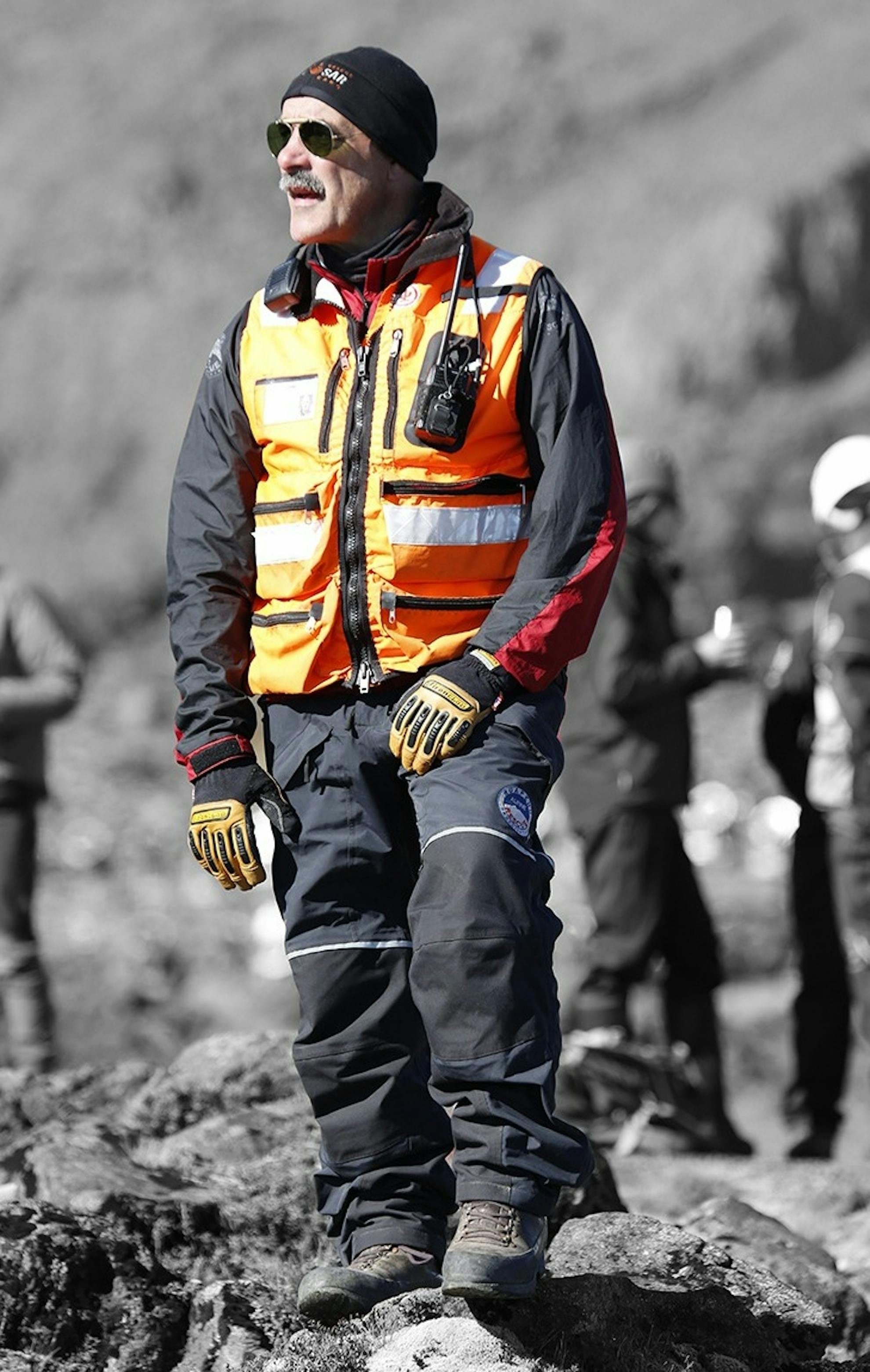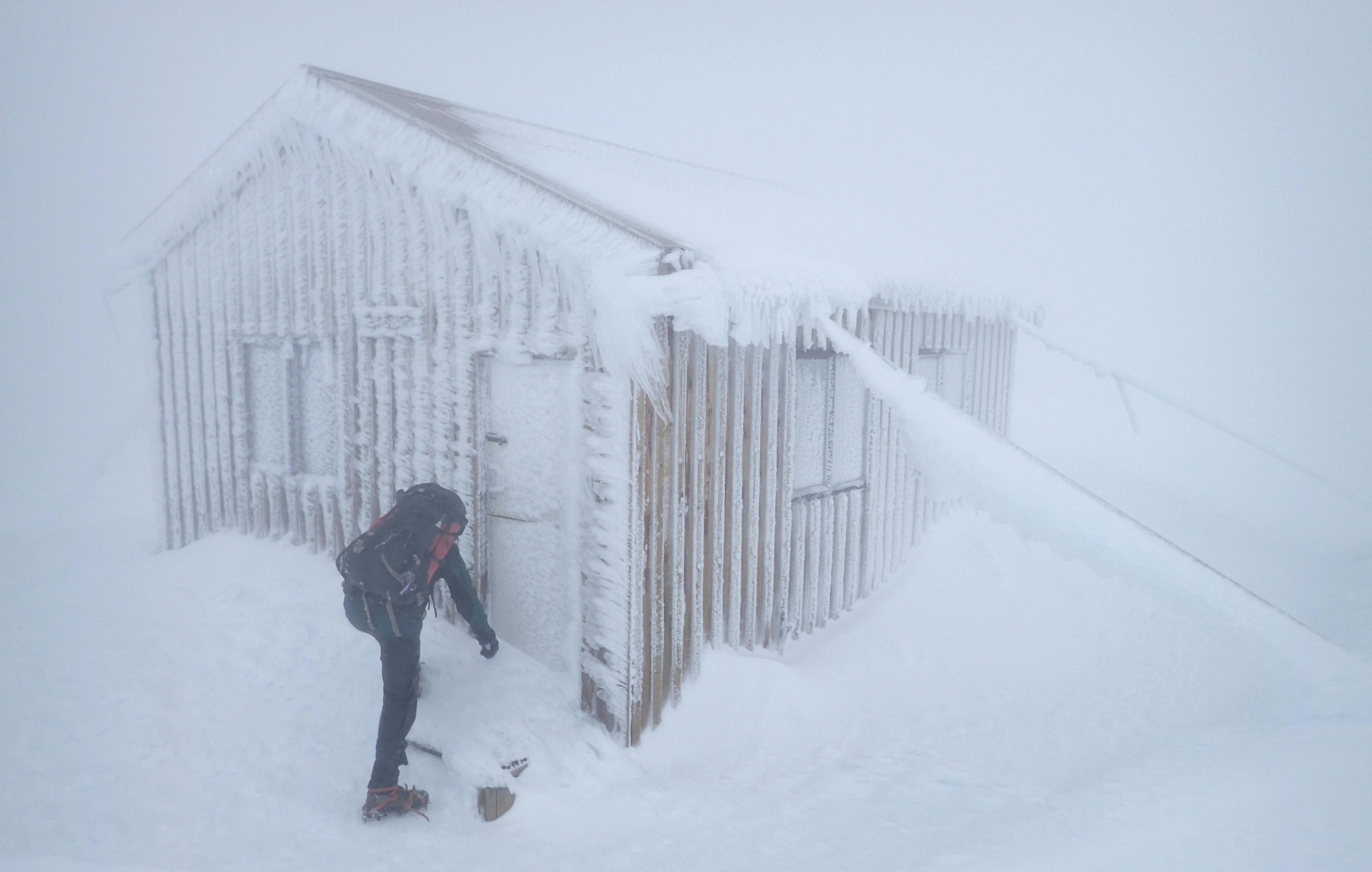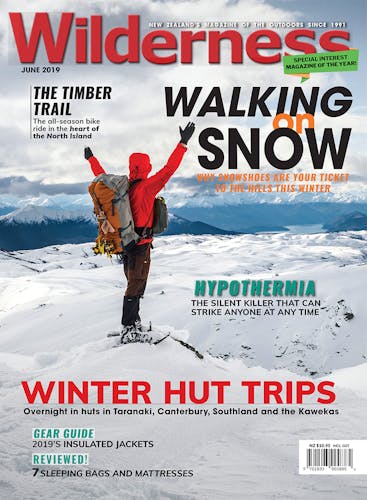No one is immune to hypothermia, but knowing the enemy can be the difference between life and death in the backcountry.
Suspended by a rope in the flow of a frigid waterfall, SAR team member Cliff Jones decided a nap wouldn’t be such a bad idea.
He’d been hanging there for more than an hour, exposed to water and wind, and his clothing was proving less effective than anticipated against the water pressure.
Feeling quite comfortable, and no longer noticing the cold, Jones’ thoughts drifted from his precarious position.
The body he was tasked with retrieving lay metres away, but it was forgotten in his hazy state.
“I had no feeling of conviction for anything I was doing. I’d lost focus on what it was I was trying to achieve, and I didn’t really care,” he recalls.
Unbeknown to Jones, hypothermia had taken hold and sapped the experienced outdoorsman of his self-preservation instincts and mental faculties.
“There was a really simple system in place to get me out, and I never used it,” he says. “If I gave a series of tugs on a rope, I would be pulled out straight away, but as bad as I was, I still thought I was the one in control.
“In the end, I sort of clung in there and didn’t do anything. I started thinking, ‘I’m actually really comfortable – I’m just going to stay here’.”
Poor visibility and the turbulent environment made communication near impossible, but Jones’ experienced team were able to recognise his worsening state and pull him out.
By that stage, he could barely move his limbs and although he didn’t lose consciousness, he has no recollection of his team’s initial first aid response.
As his core temperature was gradually increased, Jones roused to experience a wave of exhaustion and bewilderment.
“I was wondering what everyone was on about. What was I doing in a sleeping bag and why were the guys overreacting to this, when in fact they were saving my arse,” he says.
Jones isn’t being poetic when he calls hypothermia a ‘silent menace’.
In a very short time span, it can sneak up and hijack the mind of the most experienced trampers.
“You know you’re in an extremely cold situation, and you know you have to look after yourself, but then your next thought is ‘I’m doing okay’,” Jones says. “You don’t deliberately go out to expose yourself to conditions that will potentially take your life, but you just don’t know you’re getting hypothermia.”
Jones has experienced mild hypothermia several times since his first incident, but never as severely as on the waterfall operation.
“I’m totally aware of it now, and I recognise the symptoms very quickly – far quicker than others. It comes with years of being in the outdoors,” he says.
Federated Mountain Clubs ex-president Peter Wilson has also experienced the mental clouding of mild hypothermia and says it can be overcome in its early stages with training and experience.
“You can notice your thinking change, but only if you are aware and monitor it,” he says. “You know that you are gradually going to run down, and you get a chance to alert your mates or stop and treat yourself.
“If you aren’t trained, it’s damned scary and you’ll probably not tell anyone, leaving it up to others to notice the personality change.”
Hypothermia is a real risk of the New Zealand outdoors. It’s indiscriminate of age, fitness and experience, and can strike just about anywhere at any time of year.
Medically speaking, it occurs when the body’s core temperature drops below 35°C.
Dr Malin Zachau is a wilderness medical advisor who has worked alongside NZ LandSAR, NZ Police and Civil Defence to develop the NZ National Accidental Hypothermia Strategy.
She says hypothermia occurs when heat loss in the body is greater than heat production: “The human body generates heat by metabolising energy from food or from energy stored in the liver as glycogen. This fuel allows muscles to move and it is the muscle movement which generates heat. If the heat loss is greater than the heat production, the person becomes hypothermic.”
Cold stress – a state often confused with hypothermia – is the uncomfortable state which precedes it, characterised by a feeling of cold, mild, but not uncontrollable, shivering and stiffening of the fingers.
“If you do not take positive action at this stage, you will develop mild hypothermia,” Dr Zachau says.
Early symptoms include the four memorable ‘umbles’: the mumbles (trouble speaking), the fumbles (a loss of fine motor coordination), the stumbles (lack of large motor coordination), and the grumbles (bad temper and resistance to reason).
According to LandSAR Turangi’s Blake McDavitt, these initial signs are often ignored.
“Gibbering is the body’s first reaction to what could be hypothermia, but I don’t think people in the outdoors realise this is the first stage and they need to be doing something about it there and then,” he says.
In addition to hopefully raising red flags on your declining situation, each symptom is a sign that another of the body’s defence mechanisms is kicking into gear to protect the vital organs.
“The hypothalamus part of the brain notices when the person’s skin gets cold, and in order to conserve heat the peripheral blood vessels are constricted so there is less blood near the cold surface – this is why fingers and toes get cold first, go white and blue, and become less able to move,” Dr Zachau says.
Shivering begins as the muscles move involuntarily to generate more heat, and blood circulation is directed away from the extremities – including the brain – to warm vital organs.
“In mild hypothermia, shivering is uncontrollable and interferes with fine motor skills of fingers which become too stiff to undo a backpack, light a fire or unwrap food,” Dr Zachau says.
Injuries – particularly bleeding – increase the risk of developing hypothermia, regardless of outdoor temperature.
As metabolism changes, blood flow is directed away from the muscles and into the vital organs, preventing them from generating heat.
“Anybody who is injured needs to have their heat loss reduced and should have active heat added,” says Dr Zachau. “This can be done by way of warm water bottles or chemical heating packs placed on the torso, in the armpits and in the groin, taking care not to cause skin burns.”
Staggering and aggression, or irritability, can further endanger the patient by hindering decision making and mobility.
McDavitt has encountered this behaviour on hypothermia rescues and says the best way to deal with it is to try and calm the patient down, and, if possible, give them a bit of energy such as chocolate or Powerade.
“It’s amazing how quickly you can bring a patient around with energy, but you have to be careful you don’t overload them,” he says.

“If you can do the right thing – and quickly – you can usually get a good result.”
Paradoxical undressing is a behaviour sometimes experienced in the late stages of hypothermia.
As nerve endings become damaged by prolonged exposure, the patient can feel like they are overheating and remove clothing in spite of the cold.
Jones recalls a survivor who stripped during a blizzard because he thought he was hopping into bed.
“When you start finding clothing on a rescue, you know things aren’t usually going to end well,” he says.
‘Terminal burrowing’ can occur in the final stage of hypothermia, wherein the afflicted will hide in an enclosed space, often without their clothing, as though protecting themselves from the cold.
Treating hypothermia in the backcountry is difficult. On a search and rescue operation, rescuers will seal the patient in an airtight hypothermia bag with heat pads close to their main arteries until their extraction is possible.
The longer it takes to extract the patient, the greater the risk for the patient – and the rescue team.
Jones recalls a tough mission which saw three trapped hypothermic victims become six, and later nine, as members of the rescue team developed mild symptoms while awaiting extraction.
“It was looking quite bleak there for a while,” he says.
If trampers begin to experience symptoms of cold stress, immediate measures should be taken to ensure hypothermia does not develop.
Getting the patient warm and dry should be the top priority – whether this means changing out of wet clothes, layering up, or erecting a shelter.
Once the patient is dry and sheltered, carbs (warm if possible) will help the body to recover.
It is important to remember that insulated clothing and sleeping bags provide warmth by trapping body heat, and active heat must be applied to warm a cold body.
Without specific equipment, rehabilitation is not possible, and lingering ‘remedies’ – such as hopping into a sleeping bag with a patient – are outdated, and do not provide enough warmth energy to restore a medically hypothermic patient.
“It might be pleasant to share body heat if a person is in the early stages of cold stress, and it can make them feel psychologically better,” Dr Zachau says. “But the amount of heat delivered from another person’s body is nowhere near enough to re-warm a person who has become hypothermic and whose conscious level is impaired.
“Thermodynamic calculations have shown that you would need 300 naked, normothermic people in a sleeping bag to rewarm a hypothermic person.”
Adding hot water bottles may reduce further heat loss, but is also insufficient, Dr Zachau says. “The energy requirements to rewarm a person are very large and there is currently no portable device which is capable of doing so.
“A hypothermic person needs to get to the hospital as quickly as possible.”
As with any ailment, prevention is the best remedy and having a healthy respect for hypothermia is a good place to start.
Dr Zachau says Kiwis can be prone to subscribing to hypothermia misconceptions, such as: I can’t get hypothermia in the summer, I won’t get hypothermia because I’m fit, and, I’m just going out for a day tramp – I don’t need extra gear.
“Not being able to change into dry gear can be the difference between life and death,” she says.
Preparedness and adequate protection from the elements are critical in the backcountry, Jones adds.
“Sometimes I carry too much gear, but that doesn’t matter. If I don’t use it, someone else will,” he says.
Windchill is a big killer, and packing an extra windbreaker never goes amiss.
He also recommends packing decent head insulation, such as a beanie or balaclava, to prevent heat loss from the head and brain stem.
“Thermally, a baseball cap is just not going to do it. Fleece or synthetic materials work really well,” he says.
The aim is to be “comfortably warm”, McDavitt says.
“Try not to wear too much. When you heat up, you’ll want to strip off, and then the sweat will cool you down.”
Cotton is a deceptively dangerous fabric to wear when tramping, as it can absorb up to 2700 per cent of its own weight in moisture.
“Cotton kills because it keeps you wet and therefore cold, whereas merino or polar fleece doesn’t absorb water well and allows you to dry out much more quickly,” Dr Zachau says.
Peter Wilson recalls experiencing the dangers of cotton as a teenager during a tramping trip in the Marlborough Sounds.
“We had three hypothermic trampers, who got it by not changing into polypropylene underwear when they should have. They remained in cotton, perhaps out of modesty, when the rest of us changed,” he says.
“Our mistake was that we didn’t notice until later. The weather turned southerly and it began to snow. We first noticed the hypothermia as the three women began to stumble, with blue lips. They were soaked to the bone.”
The party immediately made camp in a two-person bivvy to rewarm the patients, but the experience was “very scary”, Wilson says.
As a proportion of outdoor fatalities, hypothermia is on the decline – perhaps due to improved emergency communication, higher quality clothing and education.
Despite this, any tramper – regardless of gear and experience – can still be caught out by a failed river crossing or weather bomb, so it pays to know the enemy.
Learn the signs, don’t ignore the symptoms, and pack enough for all weather, no matter the forecast.
How to spot hypothermia
Slurred or stuttering speech is often the first noticeable sign of hypothermia onset, accompanied by a loss of motor control, or clumsiness, wherein simple tasks like unzipping a backpack may become difficult.
Stumbling and a bad temper also occur and may be easier signs to pick up on if you’re keeping an eye on a patient.
Hypothermia can sneak up on trampers and make them resistant to help or reason. It is, therefore, best combated by tramping in groups, and solo trampers must ensure extra care to stay prepared and vigilant.
The stages of hypothermia
Cold stress: The stage preceding hypothermia, characterised by reduced body temperature (35-37℃), mild shivering and stiff fingers. Treat with warm sugary drinks, food, shelter and clothing layers.
Mild hypothermia: If cold stress develops into hypothermia, emergency services should be contacted. Symptoms may include confusion or personality changes, impaired motor functions, uncontrollable shivering, and a core temperature of 32-35℃. Treat as above, and add active heat such as heat pads and hot water bottles.
Moderate hypothermia (conscious): Core temperature likely 30-32℃, physical ability is impaired, and shivering has likely stopped. The patient should be kept horizontal and still, and choking hazards exist so treatment is nil by mouth. Active heat must be added, as patient has stopped producing body heat. Hospitalisation is essential.
Moderate hypothermia (unconscious): Core temperature drops below 30℃, and patient loses consciousness. Cardiac arrest risk is high, and patient should not be moved unnecessarily. Hospitalisation is essential for survival as the energy requirements to reheat the patient are very high.
Watch out for young ones
It is often marvelled that kids don’t feel the cold, but children have a greater risk than adults of becoming hypothermic, Dr Malin Zachau says.
“They tend to have a lower fat mass, meaning less insulation, and lower muscle mass, which means less capacity for producing heat, and lower metabolic reserves – or less glycogen stored in their liver – to utilise for muscle warming movement,” she says.
UPDATE: This story prompted numerous letters and a story from a reader who had dealt with hypothermia on several occassions. You can read ‘With hypothermia, caution is the better part of valour‘ in the July 2019 issue.








